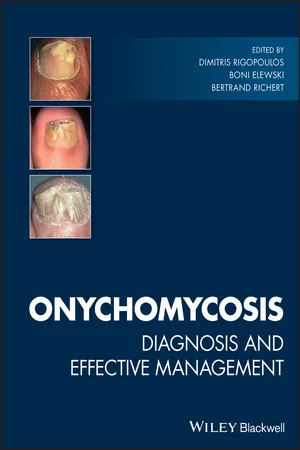
Onychomycosis
Diagnosis and Effective Management
Dimitris Rigopoulos, Boni Elewski, Bertrand Richert, Dimitris Rigopoulos, Boni Elewski, Bertrand Richert
- English
- ePUB (mobile friendly)
- Available on iOS & Android
Onychomycosis
Diagnosis and Effective Management
Dimitris Rigopoulos, Boni Elewski, Bertrand Richert, Dimitris Rigopoulos, Boni Elewski, Bertrand Richert
About This Book
The definitive guide to one of the world's most prevalent dermatologic conditions
Onychomycosis is a fungal nail disease that accounts for 40% of all nail disorders, affecting 1 out of 10 people at some stage in their lives. Compiled by leading dermatologists with expert knowledge of the condition, Onychomycosis: Diagnosis and Effective Management provides a clear and clinically focused reference tool for those looking to treat patients expediently and successfully.
This in-depth guide covers all aspects of disease management, from differential diagnosis and lab analysis to topical and systemic treatments. Designed to be a functional and accessible resource, the text also highlights key learning points, with real-life case studies and helpful take-home messages included in each chapter. Coverage of recent innovations and cutting-edge methods ensure the content is relevant to today's dermatologists, while thorough explanations of routine techniques, prognostic factors, and epidemiology make this is an excellent handbook for anyone studying the disease for the first time. The book features:
- A complete guide to the diagnosis and treatment of this common disorder
- Key learning points, case studies, and take-home messages to aid quick and easy consultation
- Insights from world-renowned dermatological experts from North America and Europe
- Over 70 illustrations
Onychomycosis is a reliable, easy-to-use companion for trainees and experienced specialists alike, and an invaluable asset to any clinic treating nail conditions.
Frequently asked questions
Information
1
The History of Onychomycosis
1.1 Introduction
| Year | Author | Comment | References |
| 1835 | Bassi | Discovers that muscardine disease of silkworms is caused by a fungus | [1] |
| 1837 | Remak | Observes microscopic structures appearing as rods and buds in crusts from favic lesions. Does not publish his observations, but allows his findings to be cited in a doctoral thesis of Xavier Hube | Not published [3] |
| 1839 | Schönlein | Communicates the fungal nature of dermatomycoses | [4] |
| 1841–1844 | Gruby | Unware of Remek’s and Schönlein’s findings, he describes clinical and microscopic characteristics of the causative agent of favus | [5–8] |
| 1853 | Meissner | Discovers that onychomycosis is caused by fungi | [9] |
| 1854 | Virchow | First to use the name onychomycosis for this new disease | [10] |
1.2 The History and Discovery of Onychomycosis


Table of contents
- Cover
- 1 The History of Onychomycosis
- 2 Epidemiology of Onychomycosis
- 3 Tinea Pedis and Onychomycosis
- 4 Clinical Features
- 5 Grading Onychomycosis
- 6a Routine and Emerging Techniques in Onychomycosis Diagnosis
- 6b Histopathology of Onychomycosis
- 6c Dermoscopy in the Diagnosis of Onychomycosis
- 7 Differential Diagnosis of Onychomycosis
- 8 Predicting the Outcome of Treatment
- 9a Topical Therapies for Onychomycosis
- 9b Systemic Treatment of Onychomycosis
- 9c(i) Laser Devices in the Treatment of Onychomycosis
- 9c(ii) Photodynamic Therapy (PDT) in the Treatment of Onychomycosis
- 9c(iii) Onychomycosis and Iontophoresis
- 9c(iv) Nail Drilling
- 9d Physical Treatment of Onychomycosis
- 9e Onychomycosis: Algorithm
- 9f Prevention of Relapse and Re‐Infection: Prophylaxis
- 10 Future Treatments for Onychomycosis
- 11 Onychomycosis in Special Populations
- 12 Onychomycosis
- 13 Home Remedies for Onychomycosis
- Index
- End User License Agreement